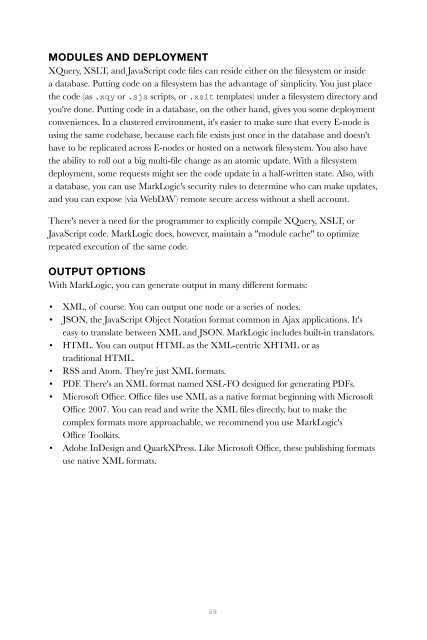You also want an ePaper? Increase the reach of your titles
YUMPU automatically turns print PDFs into web optimized ePapers that Google loves.
MODULES AND DEPLOYMENT<br />
XQuery, XSLT, and JavaScript code files can reside either on the filesystem or inside<br />
a database. Putting code on a filesystem has the advantage of simplicity. You just place<br />
the code (as .xqy or .sjs scripts, or .xslt templates) under a filesystem directory and<br />
you're done. Putting code in a database, on the other hand, gives you some deployment<br />
conveniences. In a clustered environment, it's easier to make sure that every E-node is<br />
using the same codebase, because each file exists just once in the database and doesn't<br />
have to be replicated across E-nodes or hosted on a network filesystem. You also have<br />
the ability to roll out a big multi-file change as an atomic update. With a filesystem<br />
deployment, some requests might see the code update in a half-written state. Also, with<br />
a database, you can use MarkLogic's security rules to determine who can make updates,<br />
and you can expose (via WebDAV) remote secure access without a shell account.<br />
There's never a need for the programmer to explicitly compile XQuery, XSLT, or<br />
JavaScript code. MarkLogic does, however, maintain a "module cache" to optimize<br />
repeated execution of the same code.<br />
OUTPUT OPTIONS<br />
With MarkLogic, you can generate output in many different formats:<br />
• XML, of course. You can output one node or a series of nodes.<br />
• JSON, the JavaScript Object Notation format common in Ajax applications. It's<br />
easy to translate between XML and JSON. MarkLogic includes built-in translators.<br />
• HTML. You can output HTML as the XML-centric XHTML or as<br />
traditional HTML.<br />
• RSS and Atom. They're just XML formats.<br />
• PDF. There's an XML format named XSL-FO designed for generating PDFs.<br />
• Microsoft Office. Office files use XML as a native format beginning with Microsoft<br />
Office 2007. You can read and write the XML files directly, but to make the<br />
complex formats more approachable, we recommend you use MarkLogic's<br />
Office Toolkits.<br />
• Adobe InDesign and QuarkXPress. Like Microsoft Office, these publishing formats<br />
use native XML formats.<br />
59


